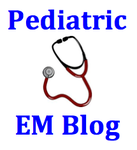|
By Dr. Kathleen Bryant
CC: Fever HPI: A 19 month old AA female presents with fever (Tmax 38.7*C) for 36 hours. Mom reports giving Tylenol/Motrin for fever control. Mom denies N/V/D, change in PO intake or change in UOP. Mom reports mild cough and nasal congestion. Immunizations UTD, no sick contacts. Physical Exam: VS: T: 38.7*C RR 16 HR 110 BP 110/80 Gen: well appearing, sitting in NAD HEENT: bilateral TMs clear, no middle ear effusion, mild nasal congestion, posterior oropharynx clear, no cervical lymphadenopathy CV: mild tachycardia, no M/G/R, capillary refill brisk, 2+ peripheral pulses Resp: CTAB, no W/R/R Abd: NTND, +BS, soft GU: normal genitalia, no rashes Discussion: No source of infection is identified in this patient. Do we need to obtain an urinalysis to rule out an UTI? Why do we care about UTIs? What is the significance of missed or delayed treatment of UTIs in this patient population?
Clinical Pearls for ED:
Author: Dr. Kathleen Bryant References: 1. Roberts, K.B., Revised AAP Guideline on UTI in Febrile Infants and Young Children. Am Fam Physician, 2012. 86(10): p. 940-6. 2. Subcommittee on Urinary Tract Infection, S.C.o.Q.I., Management, and K.B. Roberts, Urinary tract infection: clinical practice guideline for the diagnosis and management of the initial UTI in febrile infants and children 2 to 24 months. Pediatrics, 2011. 128(3): p. 595-610.
0 Comments
Your comment will be posted after it is approved.
Leave a Reply. |
Pediatric EM BlogAuthorPediatric EM Fellows at CMC/Levine Children's Hospital. Archives
November 2016
Categories
All
Disclaimer: All images are the sole property of CMC Emergency Medicine Residency and cannot be reproduced without written consent. Patient identifiers have been redacted/changed or patient consent has been obtained. Information contained in this blog is the opinion of the authors and application of material contained in this blog is at the discretion of the practitioner to verify for accuracy.
|

 RSS Feed
RSS Feed
